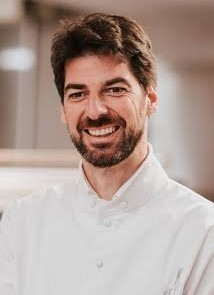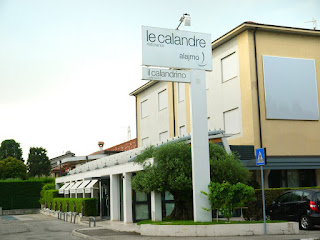NEW - Massimiliano Alajmo – Michelin-starred chef
Innovative cook is carrying on a family tradition
Massimiliano “Max” Alajmo, who at 28 years old became the youngest chef in history to be awarded a Michelin star, was born on this day in 1974 in Padua. Along with his brother, Raffaele, and his sister, Laura, Alajmo is part of the fifth generation of his family to become chefs and restaurateurs and he now helps them run a group of 14 restaurants, mainly situated in the Veneto region of Italy, as well as in Paris and Marrakech. After attending a hotel management school, Alajmo furthered his culinary education in the kitchens of Alfredo Chiocchetti of Ja Navalge in the comune - municipality - of Moena, which is in the heart of the Dolomites in Trentino Alto Adige. He then moved on to work with Marc Veyrat and Michel Guerard at restaurants in Veyrier du Lac d'Annecy and Eugénie les Bains in France. In 1993 he began working at Le Calandre in Sarmeola di Rubano in Padua with his mother, the chef Rita Chimetto, who had earned the restaurant its first Michelin star. Rubano has always been the family’s base. Alajmo was later appointed executive chef of Le Calandre. The restaurant was awarded a second Michelin star in 1997 and in 2002 it received its third. Read more…
______________________________________
Alessandra Ferri – ballerina
Dancing star who believes age is a matter of attitude
Prima ballerina assoluta Alessandra Ferri, who retired in 2007 but then made a triumphant return to ballet in 2013, was born on this day in 1963 in Milan. She marked her 55th birthday in 2018 by dancing at the Metropolitan Opera House in New York, at the Bolshoi Theatre in Moscow and the Hamburg Staatsoper, before performing at the Ravello Festival in Italy in July and in Tokyo in August. In a newspaper interview, Ferri said she was happy to be breaking barriers as an older woman in a youth-dominated world. She said she still has full confidence in her abilities and believes ageing is largely an attitude and her advice to other women of her age is ‘to keep moving’. Ferri began studying ballet at La Scala Theatre Ballet School. She moved to the upper school of the Royal Ballet School in London, where she won a scholarship that enabled her to continue studying there. She joined the Royal Ballet in 1980 and won the Laurence Olivier Award for her first major role in 1982. She was promoted to the rank of principal dancer in 1983. Ferri became principal dancer with the American Ballet Theatre under the direction of Mikhail Baryshnikow in 1985. Read more…
______________________________________
Rudolph Valentino - star of silent films
Heart-throb actor who died tragically young
The man who would become Rudolph Valentino was born on this day in 1895 in Castellaneta, a small town in a rocky region of Puglia notable for steep ravines. Born the second youngest of four children by the French wife of an Italian veterinary surgeon, he was christened Rodolfo Alfonso Raffaello Pierre Filibert Guglielmi di Valentina d'Antonguolla. When he arrived in America as an immigrant in 1913, he was registered as Rodolfo Guglielmi. His first movie credit listed him as Rudolpho di Valentina and he appeared under nine different variations of that name before achieving fame as Rudolph Valentino in The Four Horsemen of the Apocalypse in 1920. During the silent movie boom, he enjoyed more success in The Sheik, Blood and Sand, The Eagle and The Son of the Sheik and his smouldering good looks made him a 1920s sex symbol, nicknamed "The Latin Lover" and adored by countless female fans. Yet his route to fame was difficult. Unable to find work at home, he joined the exodus of southern Italians to the United States and aged just 18 boarded a boat to New York, disembarking at Ellis Island on 13 December, 1913. Read more…
______________________________________
Carlo Mollino - architect and polymath
A Renaissance man of the mid-20th century
The multi-talented architect Carlo Mollino, who designed buildings, interiors and furniture but whose talents also ran to writing and photography, racing car design, aerobatic flying and downhill skiing, was born on this day in 1905 in Turin. Mollino, whose style has been described as an eclectic fusion of the modern and the surreal, was responsible for several notable public buildings, including the Turin Chamber of Commerce and the headquarters of the Horse Riding Club of Turin, as well as several striking private residences and apartment buildings. He also designed the extraordinary Lago Nero Sled Station, at Sauze d'Oulx, the winter resort 50km (31 miles) north of Turin, and rebuilt the interior of the Teatro Regio opera house in Turin 40 years after a catastrophic fire left little behind the the 18th century facade intact. Never married in his 68 years, Mollino also had a deeply secretive side, which manifested itself in a number of apartments he kept, the whereabouts of which he disclosed to no one, not even his closest friends and acquaintances. One of these, in a 19th century villa overlooking the Po river in the centre of Turin, is now a museum, the Casa Mollino. Read more…
_____________________________________
The 1527 Sack of Rome
Mutinous army of Holy Roman Empire laid waste to city
An army loyal to the Holy Roman Emperor, Charles V, laid siege to the city of Rome on this day in 1527, at the start of the Sack of Rome, a significant event in the conflict between Charles and the so-called League of Cognac that had profound implications for Rome’s wealth and power. Rome at the time was part of the Papal States, who at the behest of Pope Clement VII had joined the League of Cognac – an alliance that included France, Milan, Florence and Venice – in an effort to stop the advance of the Empire, which had its centre of power in the Kingdom of Germany, into the Italian peninsula. After the Imperial Army had defeated the French at Pavia in the Italian War of 1521-26, it would have been a logical step for Charles to march on Rome but the attack is said to have come about not through any planned strategy but after a mutiny among his troops, many of whom were hired mercenaries, after it became clear there were insufficient funds available to pay them. Aware of the rich treasures they could seize if they stormed Rome and overthrew Clement VII, 34,000 Imperial troops, an army made up of Germans, Spaniards and Italians, demanded that their commander, Charles III, Duke of Bourbon, led them towards Rome. Read more…
______________________________________
Book of the Day: The Modern Italian Cook, by Joe Trivelli
From Joseph Trivelli, co-head chef of the world-renowned River Café, comes the ultimate classic guide to laid-back, comforting Italian food. Trivelli first learned to cook watching his Italian grandmother transform a few simple ingredients into something mouth-watering within their family kitchen. In this, his first book, he brings up-to-date all the traditional Italian food he grew up with alongside his own inventive creations. Featuring over 150 original recipes that cater for quick dinners right up to family feasts, The Modern Italian Cook conveys Joe's focus is on fewer ingredients, exquisitely prepared. With chapters on pasta, fish, meat, vegetables and baked dishes, these are recipes sympathetic to the home cook - easy to throw together but look and taste incredible every time. Beautifully designed with evocative photography throughout, this is the Italian cookbook every modern kitchen needs. The doyenne of Italian cooks, Anna Del Conte, is a fan of Trivelli's work. "All the recipes are the real classic ones and yet they all have a touch of originality which gives them a new and welcome dimension," she says.Joseph Trivelli has been co-head chef of the River Cafe in Hammersmith for the last 15 years. He regularly writes for The Guardian and The Observer.
Booking.com

.jpg)











.png)


.jpg)


